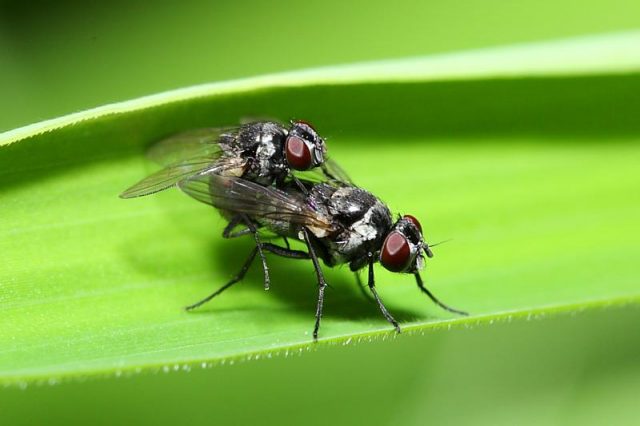Sex, alcohol and flies

Men have been drowning their love sorrows in alcohol since the dawn of times. What probably none of those lonely broken-hearted drinkers might have imagined, is that their despair would serve as inspiration for an interesting research involving sex, alcohol and flies.
As the story goes, a group of researchers at the University of California wanted to understand how the brain handles ‘natural’ and ‘artificial’ stimuli that activate the reward system, that is, the neuronal structures involved in producing pleasure. Perhaps not surprisingly, the stimuli chosen were sex and alcohol. A bit less obvious was their election of model animal: the fruit fly1.
But believe it or not, the fruit fly (Drosophila melanogaster) is considered a great model to study addictive behaviours. And in the specific case of alcohol, the effects of ethanol in flies are surprisingly similar to that of humans: they get excited with low doses, but become clumsy and sedated when they drink too much. In addition, working with flies has several advantages over other animals: they grow fast, are cheap to maintain and it is relatively easy to tweak their genome.
The experimental setting was rather imaginative. The researchers took male flies and divided them into two groups. The first group was presented with mated females (which don’t copulate) for one hour, three times a day, during four days. The second group experienced six hours of wild mating with multiple receptive virgin females. Afterwards, all males were offered two types of food: one with 15% of alcohol and one without it. The males that had experienced continuous rejection showed a marked preference for the alcoholic food as compared to males in the sexually satisfied group. The authors also tested virgin males for their alcohol preference: they drank less than rejected flies, but more than those that had mated.
These observations suggest that sexual rejection favours alcohol drinking, which is interesting but not surprising. But what about the underlying mechanisms? What is happening in the brains of these flies?
The researchers turned their attention to a neuronal molecule called NPF, that had been previously linked to ethanol consumption in flies and worms. They measured its expression levels in the flies’ brains and observed that, compared to virgin males, NPF was highly expressed in mated individuals but repressed in sexually rejected males.
But correlation does not imply causation, so the next step was to artificially manipulate the levels of NPF in the brains of the flies, and see if that affected their ethanol consumption. They did this in two ways. First, they genetically blocked the NPF receptor, so that NPF couldn’t exert its action. The blockade didn’t affect the behaviour of the virgin males, but it made the mated flies drink more.
The second approach was to artificially activate the NPF-producing neurons in virgin flies. This was done by introducing a heat-sensitive channel specifically in these neurons. When flies are kept at 20ºC, the channel is inactive, but when the temperature is raised to 29ºC, it becomes active and stimulates the NPF neurons. What happened was that at 20ºC, virgin flies behaved normally, showing some preference towards alcoholic food. However, when the temperature was raised to 29ºC, they averted alcohol.
Finally, the authors also showed that the expression of NPF in the flies’ brains increases after ethanol consumption.
Based on these results, the authors went on to propose an interesting model. According to it, NPF would be an activator of the reward system in the flies’ brain. When males mate, NPF levels increase, while frustration due to rejection decrease their levels. Alcohol can mimic to some extent the effect of sex, “artificially” increasing the levels of NPF.
A major problem with the study is that overly focused on males, a bias that affects a large proportion of the biomedical literature and that funding agencies are now trying to correct. It would be interesting to know in the future if NPF has a similar role in the female brain and if it is also regulated by alcohol. Hopefully, future studies will shed some lights on these issues.
Basic science results should always be taken with a grain of salt, but in works like this one, the temptation to extrapolate the observations is just too big. So, is NPF produced in humans? Mammalians produce a similar molecule called NPY, which has the same evolutionary origin as NPF and has been involved in different roles, including feeding, anxiety stress, sleep regulation, sexual motivation and ethanol consumption. Which makes the authors confident in stating that their findings on NPF are consistent with what is known about NPY. However, it goes without saying, the situation is certainly much more complex in humans.
It also goes without saying that artificial activators of the reward system always have side effects. The destructive effects of chronic alcohol consumption are well known. As for acute intoxication, one should always keep in mind Oscar Wilde’s word: “Alcohol, taken in sufficient quantities, may produce all the effects of drunkenness”.
References
- G. Shohat-Ophir, K. R. Kaun, R. Azanchi, U. Heberlein. Sexual Deprivation Increases Ethanol Intake in Drosophila. Science 335, 1351 (2012) DOI: 10.1126/science.1215932 ↩
1 comment
Very interesting article!!
Thanks Nacho!